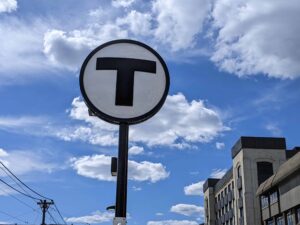
Massachusetts communities with rapid transit service have until Dec. 31 to enact zoning complying with the MBTA Communities act encouraging multifamily development. Photo by James Sanna | Banker & Tradesman Staff / File
At a board meeting of the Boston Region Metropolitan Planning Organization on Feb. 1, researchers from the state’s Central Transportation Planning Staff gave a very broad overview of some of their preliminary findings regarding the revenue potential of six measures, whittled down from a list of 10. They said their “technical” review of the revenue-raising measures will be completed this spring and turned over to the task force at that time.
“This analysis is agnostic of the political considerations of actually implementing these strategies,” said data analyst Joe Delorto, who briefed the board. Nevertheless, Laura Gilmore, senior director of strategic transit planning at the MBTA, said she expected the analysis to be valuable to policymakers.
Delorto said most of the measures would be implemented in the MBTA’s core subway and bus service area or, alternatively, the T’s entire service area. The implication was that some of the revenue-raising measures would not apply outside the MBTA service area. In response to a question from a board member, Delorto said many of the initiatives could be tweaked to assess low-income residents at a lower rate, much as Healey is currently pursuing a half-off fare for riders of the T.
The researchers examined a range of annual motor vehicle charges, including a new registration charge as well as an additional excise fee ranging from 0.25 percent to 2 percent of the value of the vehicle. Delorto said the vehicle charges could bring in anywhere from $33 million for the flat registration fee in the T’s core service area to $570 million with the 2 percent excise fee across the T’s full service area.
The gas tax analysis examined raising it from the current 24 cents to 30 cents (the average level across the New England states) or 36 cents (the average of jurisdictions between Boston and Washington, D.C.). Delorto estimated the T’s share of the gas tax revenue would be $22 million to $42 million.
The researchers looked at two tolling options – one raising existing tolls on the Massachusetts Turnpike east of Route 128, the Boston Harbor tunnels, and the Tobin Bridge, and the other adding tolls on other highways within Route 128. Delorto labeled the latter approach “congestion pricing.”
Delorto said giving half of the increased tolls (the exact amount was not specified) to the T would yield $22 million to $80 million for the transit authority. The addition of new tolling locations would generate between $220 million and $450 million, with some portion directed to the MBTA, he said.
Value capture would give the T a portion of the additional property tax revenue generated from development projects adjacent to subway lines. Delorto said the researchers looked at giving the T between 5 and 10 percent of the incremental property taxes over a 10-year period. He estimated the T’s take could range from $25 million to $85 million.
The researchers also looked at boosting the T’s share of the state sales tax. Currently, the T receives 1 cent of the 6.25 cents per dollar collected from the sales tax. The researchers said raising the T’s share to 1.25 cents would net $355 million annually. The researchers also looked at adding a 1 percent room occupancy tax in the core service area, generating $30 million for the T.
During a January presentation to the MBTA board, T staffers suggested another source of potential revenue-raising ideas by listing what taxes and fees have recently been implemented by peer transit authorities across the country. The list included a payroll tax, fare increases, gaming tax revenue, a surcharge on rideshares, a real estate transaction tax, a new tax on car sales or a tax on car rentals.
Healey’s task force, headed by Transportation Secretary Monica Tibbits-Nutt, is not just looking at the revenue needs of the MBTA. It also is reviewing funding needs and options for the transportation system as a whole, including roads and bridges and regional transit authorities. A key part of the review is expected to focus on the state’s gas tax, which is expected to bring in less and less revenue as the state shifts to electric vehicles.
This article first appeared on CommonWealth Beacon and is republished here under a Creative Commons license.![]()






